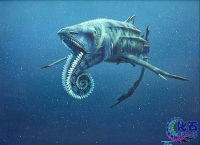 旋齿鲨 旋齿鲨
All kinds of paleontology at the world, there is a mysterious animal, and its name is spin shark. Over the years, people can see is it wonderful, spiral arrangement of the teeth (paleontology called "helical"), truly complete skeleton has not yet found, so it's "mysterious" causes a lot of paleontology the concern of experts and paleontology enthusiasts.
Russian paleontologist Carl Rotary Kempinski is the first discovery of fossil teeth shark expert, he was taken in 1899 in the Ural mountains to the fossil tooth of a beautiful spiral. At that time, he was puzzled, I do not know helical fish which should be long in the upper part of ---? In the jaw? Both upper and lower? Or in the rear? In the dorsal fin? Back or central? A year later, U.S. paleontologist Eastman to the source and location of helical proposed two major speculation: first, spiral tooth from the jaws of sharks or rays; Second, the central helical in the back, dorsal fin front.
On the growth spiral teeth, the United States, a Devonian shark expert has put forward two theories: One theory is that the base of the helical tight in the growth process together, old and new teeth pushing outward growth, as long as the meat of the nail, which can prevent tooth loss. Another theory is that the size of the helical and the support is proportional to its jaw, and only when the fish long enough to appear to spiral teeth.
Subsequently, with the jaw have been discovered and linked to samples, before deciding this is the growth spiral in the shark teeth left, right lower jaw, or left, upper right jaw joint where the location and use on the helical The debate has finally come to an end.
Fossil shark tooth rotation in North America, Norway, Russia, Japan, Greenland, Australia and other places are found, we can see it in the ocean are widely distributed. Late Permian shark began to reduce spin, few had the time to the Triassic. At present, we understand rotating only very few shark teeth, and more the secret is still sealed in the ancient rocks, waiting for experts, scholars and amateur palaeontology research and discovery.
Comb spines shark
Head spin shark extinction in a peculiar group, found in the Permian and Triassic. The sharks teeth in the upper and lower jaws around the junction of two inward curl downward into a ring shape, growth pattern is very special.
Carboniferous shark comb spine is considered to be the purpose of rotating the first representative of shark teeth, many of the features and rip it like sharks, such as double-take type of jaw, fins broad-based, high-side of the sharp teeth, the main point is low, but two sharks comb spine dorsal fin spines are different from the front of a shark breach, but the shark with the Mesozoic representatives of the same bow. Bow shark's teeth and dorsal fin spines usually saved as a fossil teeth on each side of a main point and one or more side tip crown low blunter, and with longitudinal groove; dorsal fin spine ridges and rough surface groove, ridge have warts conflict; spine anterior posterior margin of the upper and lower teeth have two lines of conflict.
In the late Mesozoic, modern sharks already prospered in Europe in the Cretaceous and Tertiary marine strata found in a variety of sharks teeth fossils. China since the late Mesozoic marine layer of very few, has yet to find fossils of modern sharks. |